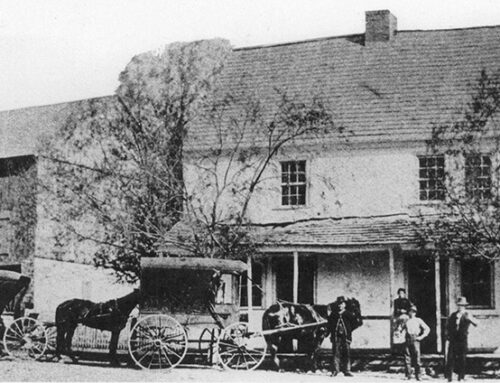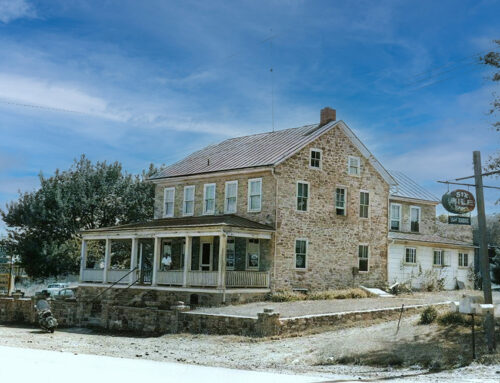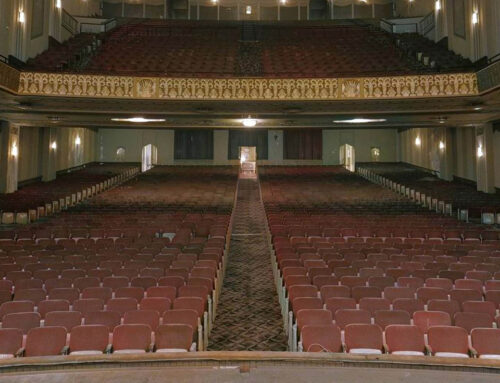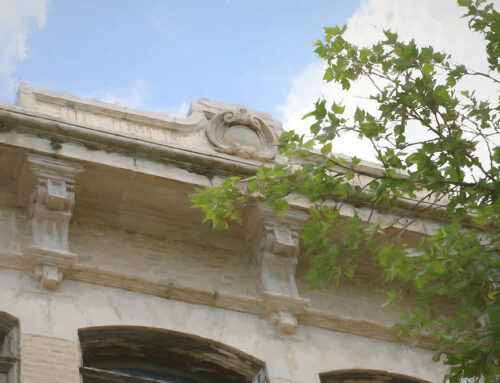Located at the Southwest corner of 4th and Cherry Streets in Reading are three distinct restaurants. Judy’s on Cherry offers Mediterranean-inspired fine dining in a beautifully renovated farmer’s market. The Speckled Hen Cottage Pub & Alehouse, is located in an authentically restored 18th century log house. The Plein Air, decorated to feel like a garden terrace in Europe, is an outdoor extension of the Speckled Hen.
The corner properties were purchased in 2001 by Judy A. Henry, former chef at the Peanut Bar. The complex consists of three old structures. The log house actually was built in the 1750s. The federal-style home next door, named the John Hiester House for its most prominent early owner, was added to the complex between 1790 and 1810, and in 1895, the West Reading Markethouse was built west of the log home. All three structures are on the National Register of Historic Places.
Below: Speckled Hen Cottage Pub & Alehouse, 4th and Cherry Streets, Reading, PA.

Below: Southwest corner of 4th and Cherry Street about 1892.

The log cabin, at 30 South Fourth, was then occupied by Charles A. Z. Griesemer, an alderman who sold insurance and real estate and lent money “in large or small amounts.” He advertised his office as being at “the Log Cabin.” The double home on the corner was razed to widen Cherry Street.
The former proprietor of the log house, Susan Brubaker, bought the property in 1978 and opened it as a restaurant in January 1980 after spending 18 months restoring the 20-by-20-foot 18th century log house. Susan Brubaker named the restaurant Widow Finney’s after Sarah Finney, who with her husband, Joseph, was among Reading’s earliest settlers. But widow Finney didn’t live here. This house was built for Nicholas Werner in the 1705s. He took title to out-lot 53 of the 1748 town plan of Reading.
Below: 1748 Town Plan of Reading.

Widow Finney’s house was about two blocks East near 3rd and Franklin Streets. The house was built on a 150-acre tract of land owned by Samuel Finney, father of Joseph Finney. Joseph Finney, son of Samuel Finney, was born on May 2, 1684. Sarah Finney (Lawrence) was the 2nd wife of Joseph Finney. Joseph is portrayed as a pioneer homesteader and Sarah as a genteel English lady from a respectable Philadelphia family, who accompanied her husband to the area out of a sense of wifely duty.
Joseph Finney was deceased by the year 1733 leaving Sarah with at least five minor children. A sixth child, Joseph, had preceded his father in death at age eleven. Their other sons, Samuel and John, died in 1734 and 1737. The three daughters Sarah, Ann, and Rebecca would marry Lawrence Thompson, Thomas Thompson, and James Hart, respectively. Widow Finney, however, stayed on the land and opened an inn, and the Finney Farm became a travelers’ landmark. In some of the earliest records the town we know as Reading was referred to as “Widow Finney’s Town.” Sarah Finney continued to serve travelers to the area before her death in 1743.
The location of Finney cabin is shown on a copy of a survey made by Benjamin Lightfoot which very clearly places the Finney homestead just south of Penn Street, and near what is now Third and Franklin Streets. The original map is with the collection of Benjamin Lightfoot papers at the Pennsylvania Historical Society in Philadelphia.
Below: Location of Original Widow Finney House.

By 1739 other land grants were issued by Thomas and Richard Penn, sons of William Penn. Samuel Finney’s lot (for his son Joseph Finney and his wife Sarah) of a hundred and fifty acres was just south of the Ford (shallow place) in the Schuylkill River. Thomas Lawrence purchased a tract with the Ford running through the middle of it; three-hundred acres adjoining the Finney tract. Later he purchased another a hundred and thirty-seven acres to the east of his parcel. The tract north of the Lawrence parcel still belonged to the proprietor Thomas Penn, and the next tract north was purchased by Thomas Penns good friend Richard Hockley.
Some years after these grants had been made the Penns conceived the idea of laying out a town of Reading and made an effort to repurchase the ground. The Hockley tract was considered to be best adapted for the purpose, but its distance from the Ford, which was opposite the Lawrence property, militated against it; then again, on the Hockley land, water was not so abundant near the surface, whilst on the Lawrence and Finney properties fine springs bubbled up at many places.
As soon as the owners of the Lawrence and Finney tracts were aware of the desire of the proprietors they refused to sell. This produced a momentary change in the design of the proprietaries. Because Lawrence was holding out and being difficult to deal with, the Penns explored another lay-out which placed the town farther north, almost opposite the mouth of the Tulpehecken creek. This survey is now only known as an appended portion to Reading, under the designation of the ‘Hockley Out-Lots.’
Below: 1739 Land Patents showing Hockley Out-Lots.

In attempting to purchase the plantation of the Widow Finney it was discovered that Thomas Lawrence, prominent politician and speculator, had acquired co-rights with her to the best part of the tract desired for the town, including the ever necessary Ford; and Thomas Lawrence would not sell. He knew that the town would expand soon beyond the limits of the proprietary tract at its center, and wanted to keep his land intact. The proprietaries, unwilling that any but they should hold a controlling interest in one of their ventures, would not begin until the disputed acres were theirs. Negotiations dragged on, and in the midst of them, in her lonely cabin on the Schuylkill, attended by her three daughters, the Widow Finney died in the year 1743.
In the spring of 1743 a concerted effort was made to educate Mr. Lawrence to the advantages of complying with the proprietary wishes, and at first it had success. Lawrence, however, again disappointed them, asking fifty pounds and “half the Town” in exchange for his outlying tract.
Two years passed. On December 6, 1745, Thomas Lawrence signed over all his land (437.5 acres) to a simple yeoman, Thomas Jenkins, for 460 pounds. However, Thomas Jenkins had been secretly hired to make the purchase by Penns agents, Richard Peters and Dickie Hockley. When Lawrence found out whom the real purchaser was he left the area furious; he died in 1754.
In 1748, after much delay by William Parsons, surveyor for the Penns, the town of Reading was laid out. The town plan was comprised of 520 lots, and 204 out-lots, numbered consecutively. It was named Reading, after the county town in Berkshire, England.
In choosing names for streets the dutiful William Parsons tried hard to flatter his employers, the Penns. The main thoroughfare was named for the Penn family and the main intersecting street was named Callowhill (now Fifth St.) in honor or Hannah Callowhill, William Penn’s second wife. Present-day Franklin St. was named Richard and Washington was named Thomas, both names honoring sons of the Founder. Walnut St. was originally Margaret St. in honor of one of Penn’s daughters. Other streets were named in honor of Penn’s friends in England.
In February 1749 three commissioners were appointed to sell the lots upon which a city was to be built. These commissioners were Francis Parvin, William Hartley and Conrad Weiser. In 1751, 1752, 1753 and 1754, patents were issued for 241 lots, and if the conditions of sale were complied with, there were in the town, by the year 1755, at least two hundred dwellings and one thousand inhabitants.






Interesting read. Joseph Finney and Sarah Lawrence Finney are my eighth great grandparents. I will plan a visit soon.